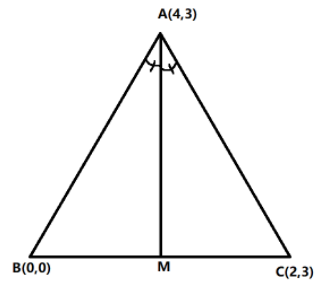Question
Question: Find the equation of the bisector of the angle \(A\) of the triangle whose vertices are \(A\left( {4...
Find the equation of the bisector of the angle A of the triangle whose vertices are A(4,3), B(0,0) and C(2,3).
Solution
We will first draw the diagram for the corresponding conditions. Let AM be the angle bisector angle A. Then, find the coordinates of M using the property of angle bisector and section formula. Then, find the equation of line AM from the coordinates of A and M.
Complete step by step solution: We are given that the coordinates of vertices of a triangle are A(4,3), B(0,0) and C(2,3)
Let AM be the angle bisector of angle A
We will first draw the corresponding figure.

Since AM is an angle bisector, then AM divides the opposite sides of the triangle into two segments which are proportional to the distance of the other two sides.
That is, AM divides BC in the ratio of AB:AC
Hence, AB:AC=AM:MC
Now, let us find the distance AB and the distance AC using the distance formula,
If (x1,y1) and (x2,y2) are coordinates of two points, then distance between them is calculated as (x2−x1)2+(y2−y1)2
AB=(4−0)2+(3−0)2 ⇒AB=16+9 ⇒AB=25 ⇒AB=5
Similarly the distance of AC is,
AC=(4−2)2+(3−3)2 ⇒AC=4+0 ⇒AC=4 ⇒AC=2
Thus, the ratio of AB:AC is 5:2 which is also equal to AM:MC.
We shall now find the coordinates of M using section formula,
Section formula states that, if (x1,y1) and (x2,y2) are coordinates of two points and they are divided by the point (x3,y3) in m:n,

then the coordinates of (x3,y3) are (x3,y3)=(m+nmx2+nx1,m+nmy2+ny1)
Therefore, the coordinates of M can be calculated as,
M=(5+2(5)2+(2)0,5+2(5)3+(2)0) M=(710,715)
Next, we will find the equation of line AM using the points A(4,3) and (710,715)
If (x1,y1) and (x2,y2) are coordinates of two points, then the equation of line is given as,
y−y1=x2−x1y2−y1(x−x1)
Therefore, equation of AMis
y−715=4−7103−715(x−710) ⇒y−715=71876(x−710) ⇒y−715=31(x−710) ⇒3y−745=x−710 ⇒3y−x−745+710=0 ⇒3y−x−735=0 ⇒3y−x−5=0
Hence, the equation of the bisector of the angle A of the triangle whose vertices are A(4,3), B(0,0) and C(2,3) is 3y−x−5=0.
Note: Section formula is used to find the coordinates of the point when the point divides the line joined by two points in a certain ratio. If the point (x3,y3) divides the line internally joined by the points, (x1,y1) and (x2,y2), then the coordinates of the point is given as (x3,y3)=(m+nmx2+nx1,m+nmy2+ny1). But, if the point (x3,y3) divides the line externally, then the coordinates of the point is given as (x3,y3)=(m−nmx2−nx1,m−nmy2−ny1)
